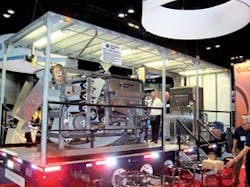Jim Montague is the executive editor for Control, Control Design and Industrial Networking. Email him at [email protected] or check out his Google+ profile.
Because the universe tends toward entropy, the catch-all saying, "It's not going to clean itself," applies to pretty much everything, including solid waste.
In the case of wastewater treatment, cleaning usually means running sewage through anaerobic processes in a series of cement tanks located near every urban and suburban community.
Bacteria, motion, sunlight and other factors break down much of the contaminants, but there's always some material left over. So one of the most important processes in wastewater treatment is removing as much water as possible from this sludge before it's trucked away to landfills, incinerated or converted to biosolids for fertilizer.
This is where Charter Machine (CMC) comes in, albeit by a slightly indirect route. The 45-year-old, full-service machine shop is capable of large- and small-run machine work, and has made custom equipment for Eastman Kodak, Mitsubishi, Coca-Cola and other well-known clients. Located in Metuchen, N.J., Charter originally was named Graphic Equipment Corp. (GEC), and specialized in work for the printing industry, including making its GEC turret rewinder since 1974. However, it subsequently diversified into many other machine applications, including serving and supplying parts for sludge dewatering devices.
"Passavant-Roediger is based in Germany, and its U.S. division built its dewatering machines in Pittsburgh for more than 20 years, but it was flooded out by Hurricane Ivan in 2004," says William Wright, Charter's national sales manager. "Despite the flood, the company still had existing machine orders and a sales office, so it looked for someone to build its precision equipment and found and hired Charter. We built Roediger's machines for about three years, but the division declared bankruptcy and became available for sale in 2006, so Charter decided to buy it. We already had a good relationship with Roediger and had its parts and frames. The acquisition helped us fill our shop and gave us another good egg in our basket."
Besides ramping up its own engineering staff to handle projects following the acquisition, Charter also brought over a good chunk of Roediger's former U.S. employees, many of whom are still with the company. "Charter can build anything, so we hadn't initially planned on setting up a dedicated dewatering division, which would have taken years to design and market," explains Williams. "We didn't do any marketing about acquiring Roediger because we just saw it as having the capability to help our existing customers."
Charter Machine's TP7.4 tower press is a truck-mountable, belt-filter press with a 0.7-meter wide belt that removes moisture from wastewater sludge following biological processing to minimize disposal weight and costs.
Charter is entering its seventh year of successfully supporting and building its Roediger line, which many U.S. biosolid treatment plants have relied on for years. For example, at the recent Weftec 2013 tradeshow in Chicago, Charter exhibited its smallest, belt-filter press, TP7.4 tower press, which has a 0.7-meter-wide belt, and is more compact than the firm's largest presses that have up to 2.2-meter-wide belts. The company says that all tower presses have an innovative center pivot design that is friendly to EUR-Lex emissions standards and is easier on its belts by improving belt alignment. This center pivot adjusts both sides of the belt simultaneously for quicker performance over its life.
In addition, TP7.4 allows smaller wastewater facilities with the same problems as larger plants to have the same center-pivot design, same vertical arrangement of rollers and same individual drip pans. Also, all TP7.4s are customized with a rotating gravity zone for smaller footprints.
Because dewatering often is needed in multiple or remote locations, TP7.4 and many of Charter's other presses can be mounted on a semi-trailer truck and transported to a user's location. This flexibility is useful for dewatering of sludge storage facilities that have become filled to capacity, or dewatering industrial sludge lagoons onsite rather than pumping the sludge long distances. One mobile unit also can dewater a number of sewage plants in the same community, and provide it with dewatering capability without adding costly construction or renovation expenses.
The belts on all Charter's presses are covered with micro-strands that have an opposite electrical charge to that of a pre-treatment polymer added to the sludge, so the suspended solids are attracted to and collect on the strands. The belt filters are also porous, so water in the sludge is squeezed out as the belts run through a series of vertically aligned rollers. The equipment also has stainless-steel drip pans positioned under each roller to prevent rewetting of the sludge, and to keep moisture content to a minimum. The presses typically handle sludge that's 1% to 5% solids and turns it into "cake" that's usually only 10% to 12% water. In short, this means municipal utilities aren't paying to have water hauled away.
To further improve performance of its belt-filter presses, Williams reports that Charter migrated from relays to Rockwell Automation PLCs. It also uses the supplier's operator interface terminals, which can be linked to a treatment plant's SCADA system. TP7.4 also employs Siemens' motor starters; Emerson Control Techniques' 5-hp and 2-hp variable-frequency drives, ABB's 480-to-120-V transformers for control system power, and two of SEW-Eurodrive's 1-hp motors. One motor runs the belt, while the other is for the drum, where the sludge is initially dumped before entering the rollers.
"We use each customer's specifications and then do everything we can to build their machines based on what they need," says Williams. "We've built equipment for many businesses, but solid waste processing is always going to be here."







